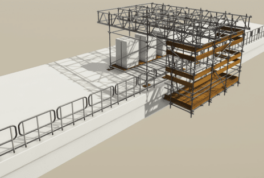Assessing constructability and buildability at IDH
March, 23rd 2022
When reviewing structures, whether for temporary or permanent works, we assess for constructability and buildability at IDH. But what do we mean by those terms and why are they such important stages in construction?
What is constructability?
Constructability is a technique where construction processes are reviewed from start to finish during pre-construction phase. It’s an important phase and helps to identify obstacles before a project is built to reduce or prevent errors, overrunning costs and delays. Constructability is often used to refer to permanent works, rather than temporary works.
Constructability is described as “the extent to which the design of a building or construction project and its environment facilitates ease of construction, subject to the overall requirements of the building or construction project and its environment.” Network Rail Safe by Design, Guidance Note – Early Focus on Constructability and Temporary Works (2019)
What about buildability?
In temporary works, we often use the term “buildability”. For us, this is firstly, and most importantly, about safety.
When building, using and dismantling falsework and formwork structures, the designer needs to consider, and document, the risks involved in each design process and consider buildability at all times.
Examples of buildability risks are manual handling of materials and the stability of falsework structures.
It’s important that our engineers understand the weights of individual components that they design with every day. Detailing steel soldiers and large proprietary formwork panels may need to be avoided, particularly if they are to be lifted or moved manually. If the wrong formwork product is detailed there is a high risk of injury due to the constraints of manual handling.
Thought should always be given to the stability of all temporary works structures. Consider, for example, a falsework tower 10m high with a base width of 1.8m. This exceeds the guidance of what is stable and there is a very high risk of the tower overturning which may cause an injury or worse still a fatality – it is not buildable.
We adhere to several codes of practice, guidance documents and regulations at IDH, including:
- The Work at Height Regulations 2005
- The Construction (Design and Management) Regulations 2015
- BS 5975:2019 Code of practice for temporary works procedures and the permissible stress design of falsework
- NASC TG20:21 Operational Guide
- Formwork – a guide to good practice, 3rd edition.
It’s all too easy to design behind a desk without understanding the safety aspects of work on-site. That’s why IDH places a lot of emphasis on assessing the buildability of each project, as well as its constructability.
To learn more, Anthony Kenmare is on hand to offer his expertise or you can reach us on:








